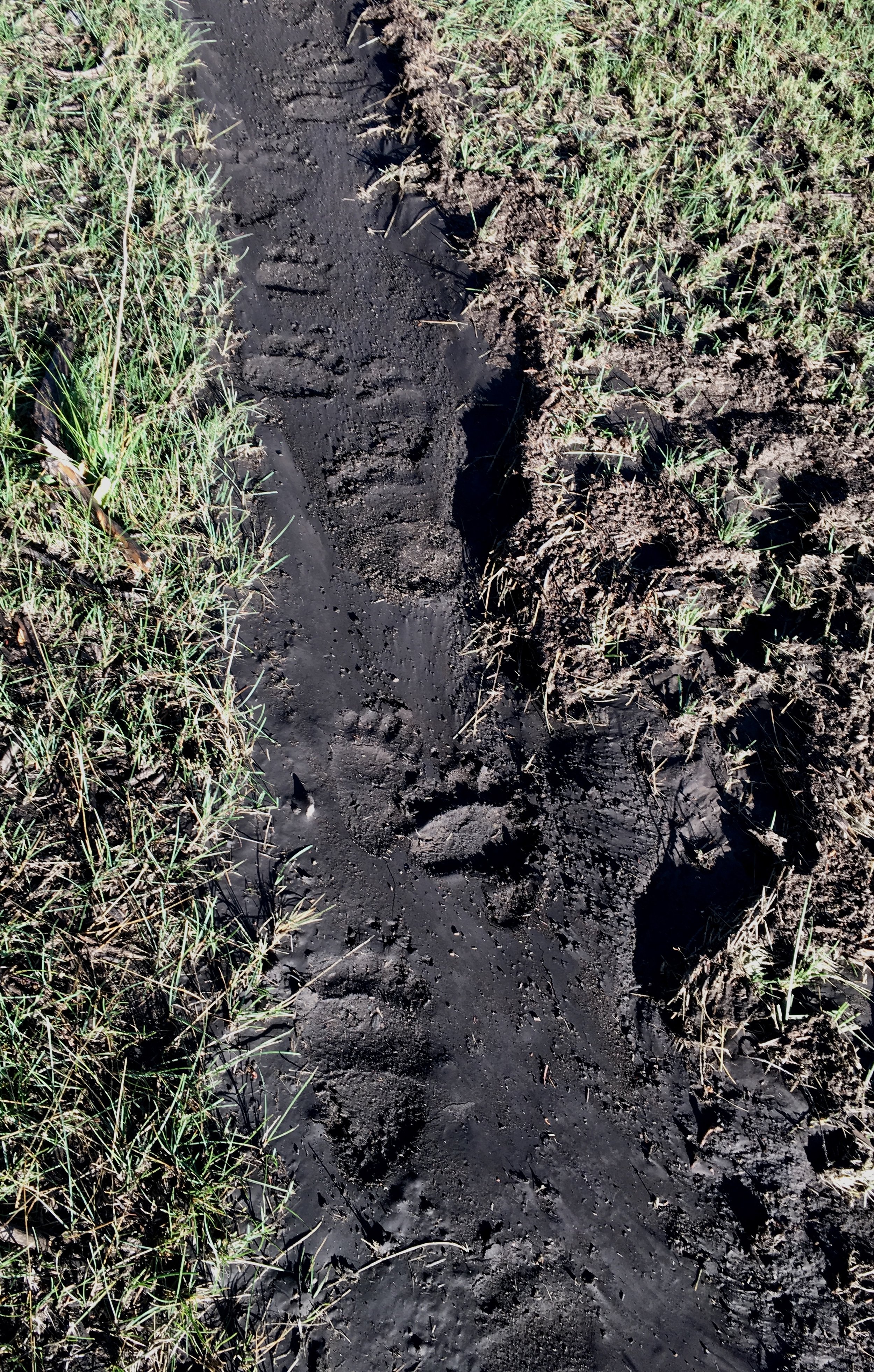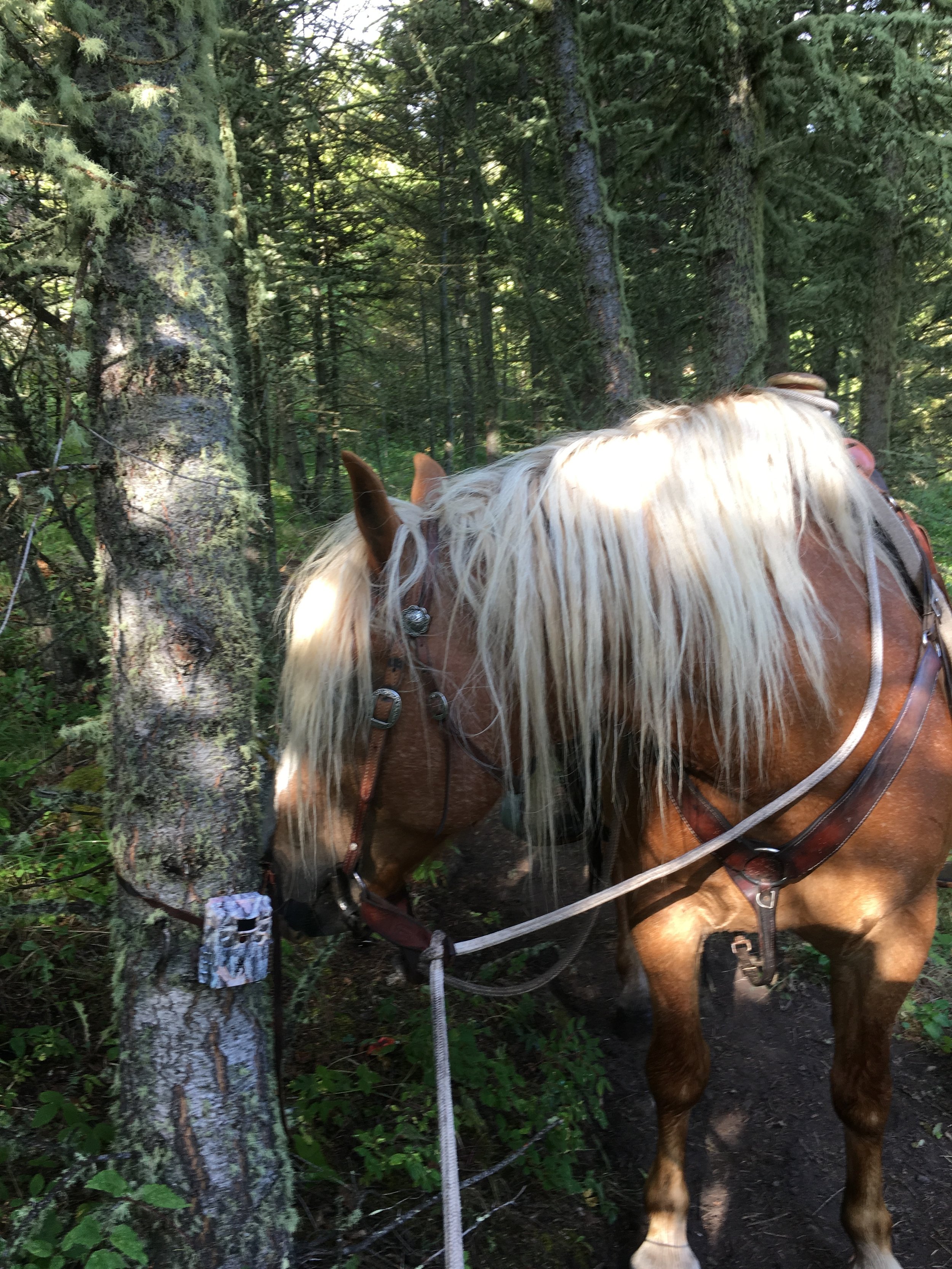Forestry Permit Update
The forestry permits that I monitor within the Gallatin National Forest have continued to have high bear activity throughout August. One benefit of riding this area consistently is the ability to notice shifts in wildlife presence on the landscape. Last Friday, August 16th, it was a very cool and clear morning. The previous evening storms had rolled through that dumped over half an inch of rain in a very short period of time. Since it had been quite dusty before this storm, the rain allowed the trails to become a fresh canvas for new tracks. The trail camera did not have an SD card at the time and the tracks left behind were the only way I could gather what was going on in this particular permit area.
It was a loud morning in the permit. When riding to permit that day, I thought one of the livestock mangers must have been moving cattle because of the persistent calling of cows. Usually it is a fairly quiet ride up to the permit area and when I arrived at the gate, one older cow was present. After confirming with a livestock manager that no one was pushing cattle, I continued on my ride and saw no fresh cattle sign or presence. What I did see was plenty of bear tracks, all heading towards the permit gate area. The tracks I found included both black and grizzly bear as well as a grizzly bear cub.
On my ride back I couldn’t help but notice quite a large rock that had been moved from its location by a grizzly bear. Rather than rotate the rock over on its long end the bear was strong enough to stand the rock on its small side- this just shows the remarkable amount of strength grizzlies have.
When I returned to the permit gate the older cow was still there, she was in the wrong permit area and was from another herd. When she was walking, I noticed lameness to her gait. I was not able to get in contact with the livestock manager due to poor phone reception and made the decision to bring the cow back to its home ranch where two other lame cows that never went to permit resided. As I pushed the cow home it was easy for me to see why she was alone- walking over logs was difficult for her as was climbing uphill. When I talked to the livestock managers that evening about the cattle locations from the raucous that morning I mentioned that despite the overwhelming number of bears traveling through that area, I did not believe the bears were out for blood and hunting the cattle because the lame cow I brought back to its home ranch was completely unharmed.
There were three total carcasses found over this summer. One was definitively a larkspur caused death, one carcass was too consumed to determine why the cow died and the third was recently found so no verdict yet. The last carcass found was drug through the fence from forestry permit onto private ranch-land by grizzly bears, the plural of bear used intentionally due to the variety of different hairs snagged in the barbed-wire fence.
The hooves behind the permit rides…
I do not own any of the three horses I used during the cattle monitoring period within the forestry grazing allotments. The bay quarter horse, “Marvin”, I have worked with the past couple years for another ranch. The Appaloosa, “Appie”, belongs to one of the livestock managers. The last of the three musketeers is a Haflinger named Kevin that is owned by a ranch manager near the Tom Miner Basin who I knew from working other horses he owned.
These three fellas put in many long days and my summer would not have been the same without these 4 legged co-workers that had to be mountain horse and cowhorse. Marvin and Appie came into the job as cowhorses. Once I taught Kevin the basics of cattle-work in high country he also became quite keen for the opportunity to move cattle.
All three horses have returned to their homes and I just finished storing the last of the electric fencing equipment I used for setting up temporary fencing for them throughout the summer.
When the Range Rider isn’t Range Riding
You’ve been reading my blog posts all summer but now for a little more information about myself. I come from a mixed background- I am both a PhD student and a range rider. I worked for ranches within the Greater Yellowstone ecosystem long before I ever considered pursuing research here. All through my undergraduate career, as soon as exams would finish, I would head to the high country, packing horses, guiding, working cattle or bison until the last split second before I had to return to school for another semester. I conducted research in Ecuador on environmental degradation and health disparities for my undergraduate honors thesis with a particular focus on dengue fever and malaria. I planned on returning to Ecuador to conduct my PhD research until I was asked if I had considered doing research in the place I had guided for so many years: the Greater Yellowstone Ecosystem.
During my first year of graduate school I was awarded the National Science Foundation Graduate Research Fellowship (NSF GRFP). The NSF GRFP is an award to a future scientist based off of a research proposal and personal statement about how his or her background has prepared them for this path. My NSF GRFP research proposal focused on human-wildlife conflict and that although we think of Yellowstone as such a unique place, agricultural landscapes surrounding national parks and preserves is a human-wildlife conflict hotspot across the globe. In this proposal I noted that some of these agricultural spaces such as the ranchlands in the Greater Yellowstone Ecosystem provide an ecosystem service by maintaining open space and migration corridors that might otherwise be overtaken by residential development. It is important to recognize the gray space ranches occupy within the Greater Yellowstone Ecosystem. I am not saying that ranches are the most environmentally friendly thing; however, it is the best shot wildlife have at survival, especially in the face of global climatic shifts and increasing residential development within the Greater Yellowstone.
This is my sign off for the season, one of the two herds I have monitored we are currently bringing in from permit and the other herd will return to the home ranch by September 1st. I am back to graduate school and if you have any questions about my research my email of contact is Sabrina.bradford@colorado.edu
-Sabrina Bradford, Tom Miner Range Rider






